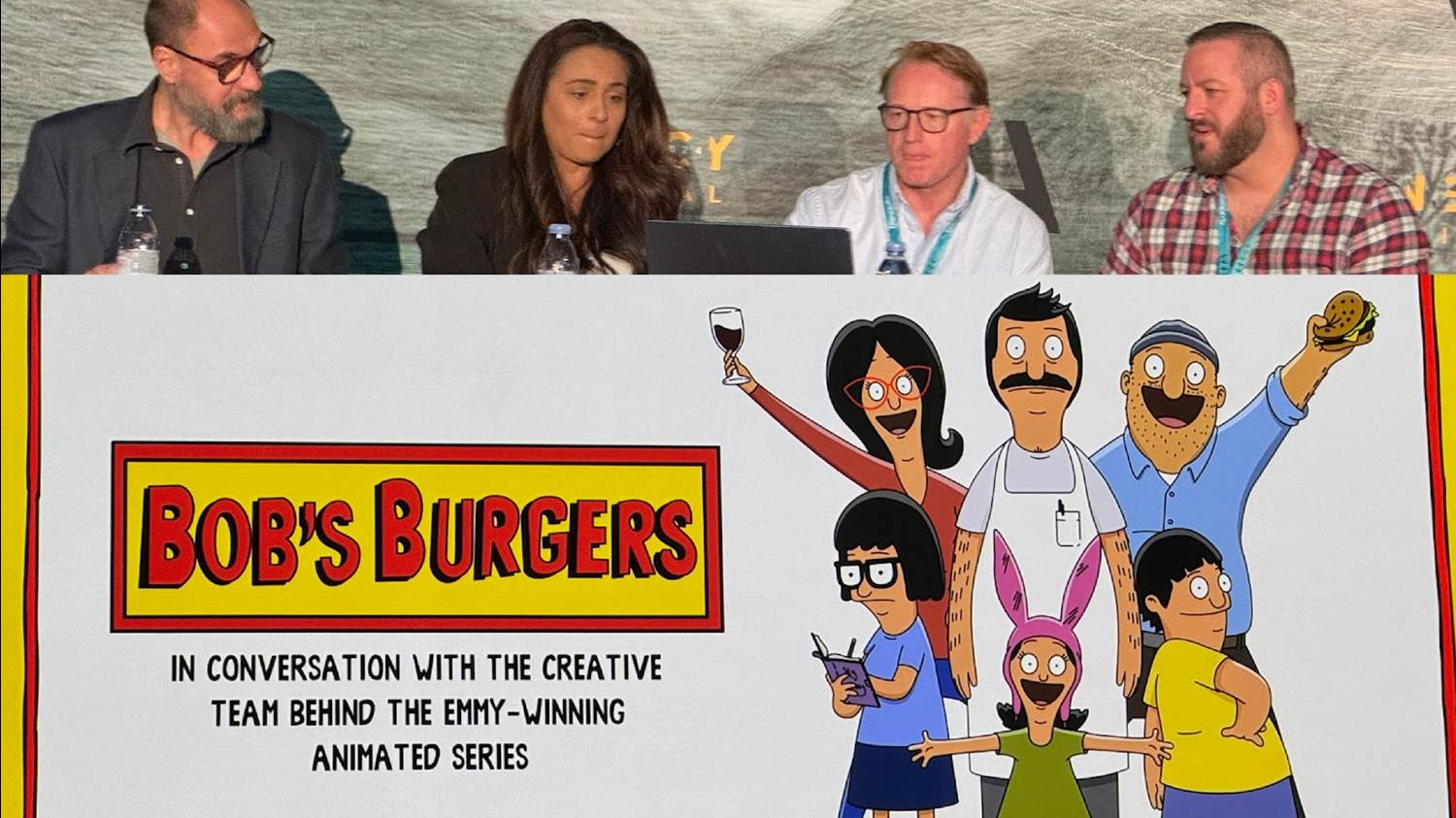20th Television Animation made its Annecy Festival debut with a look behind the scenes of Bob’s Burgers, which is coming back for Season 15 on FOX this fall. Series creator Loren Bouchard was joined by fellow executive producer Janelle Momary-Neely and two supervising directors, Bernard Derriman and Simon Chong. Loren Bouchard’s passion for animation reverberated throughout the panel, addressing animation students in the audience about how every story has to be protected at every step within the animation pipeline. The analogy he gave was holding a birthday cake with lit candles and trying to walk without any of the flames blowing out.
On Bob’s Burgers, each episode’s life begins in the story room, where a team of writers work to outline the episode’s beats. With that outline, a script is written, and the recurring voice cast is brought into the studio to record the dialogue as a group, which Loren Bouchard says gives each episode more chemistry and energy than having the actors record individually.
With that “radio play” recorded, a “thumb pass” is created (like storyboards, but less detailed), primarily used for blocking. After 14 seasons, the team has an extensive library of backgrounds they can quickly place behind quick outlines of characters. When a scene requires a new angle, they have a computer-generated model of frequently-used locations with which they can create a screenshot, which will then become a background further down the pipeline. Each thumb pass generally takes about two weeks to complete.
From there, the “thump pass” is transcribed as an animatic version of the episode, which will become a great resource for overseas animators to follow. The software used on Bob’s Burgers is populated with all of the main characters from multiple angles, although story artists are free to draw themselves. It’s more of a time-saver, although to ensure consistency, heads are almost always copied and then tweaked if a different expression is needed. The animatic storyboards typically take four weeks to create. Bob’s Burgers also utilizes color scripts for every episode, which are based off the animatic.
With an animatic version of the episode available, the writers reconvene and make some fixes. At the next recording session, the voice cast will re-record for any dialogue changes that have resulted from this step in the process. And that audio file then goes to mixing, which is another area that Loren Bouchard keeps a close eye on, as a bad sound mix can drain some of the energy from the show.
As an executive producer, one of the resources Janelle Momary-Neely is consistently updating are character model sheets, size comparisons, expression sheets, and character walk cycles in an effort to keep the animation consistent. These reference tools are also utilized in the thumb pass and animatic stages, particularly for size comparisons and expressions. When an episode calls for a new character, Janelle also oversees the finalization of their design, filing those resources away in case that character ever makes another appearance. The animatic version of the episode is transformed into timing and exposure sheets, which are then sent to two different animation teams, both in different timezones. It generally takes fifteen weeks for the animated episodes to be returned.
With the episode back in the creator’s hands, a retake director and a team of seven animators go about fixing anything that the team isn’t happy with. As a former retake director, Simon Chong shared that sometimes new storyboards are created to fill holes in the episode. When it comes to animation that the team isn’t happy with, he stressed the importance of self-reference. He showed an example of a sequence wherein Bob picks up a sheet metal door. It looked too dull in the original animation, so one of the animators filmed himself doing the same task, and discovered that he subconsciously hiked up his pants before bending over, an action that was then given to Bob to make the movement feel more natural.
Music is the last step in the Bob’s Burgers pipeline, and Loren Bouchard sang the praises of the show’s two-person music team. As an example of their unwavering dedication to the show, he talked about a Season 14 episode called “Pipe Guy,” in which a character plays a PVC pipe machine using a pair of flip-flops. The team created a handmade PVC pipe kit to play for that moment and also recorded the show’s theme song on that instrument for the end credits.
As evidence of the passion and dedication of the Bob’s Burgers team, Loren Bouchard closed out the panel with a look at the end credits. Nobody at FOX asked them to change the end credits every episode, and he admitted that it’s a fiscally irresponsible thing to do. But it brings them so much joy to continually leave the show’s fans with something sweet at the end of every story they tell.
Past episodes of Bob’s Burgers are available to stream on Hulu (and Disney+ with a linked Hulu subscription). Season 15 will premiere this fall on FOX.

